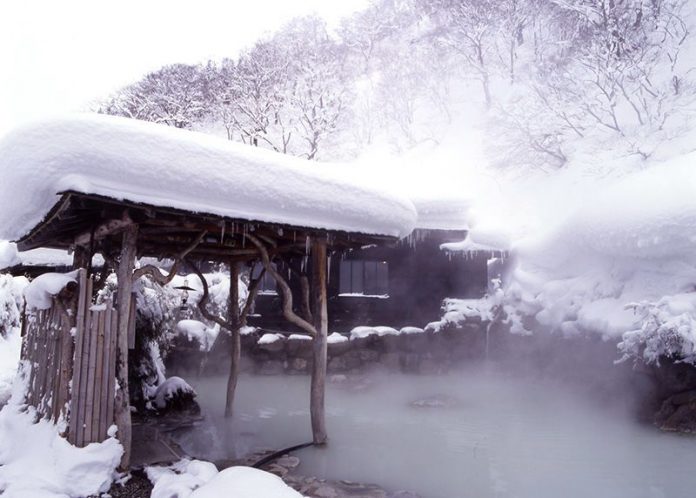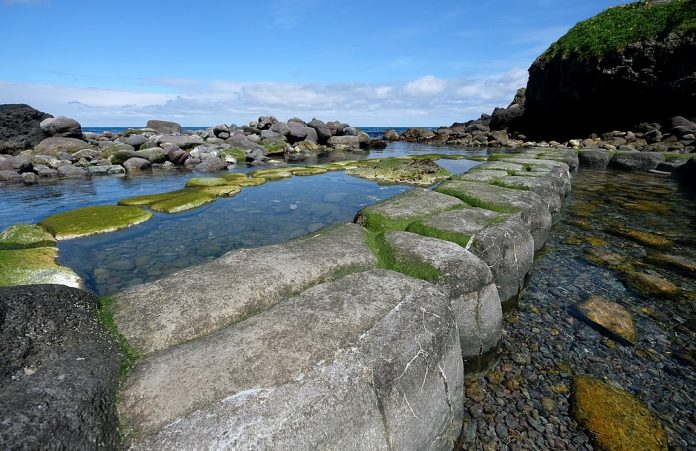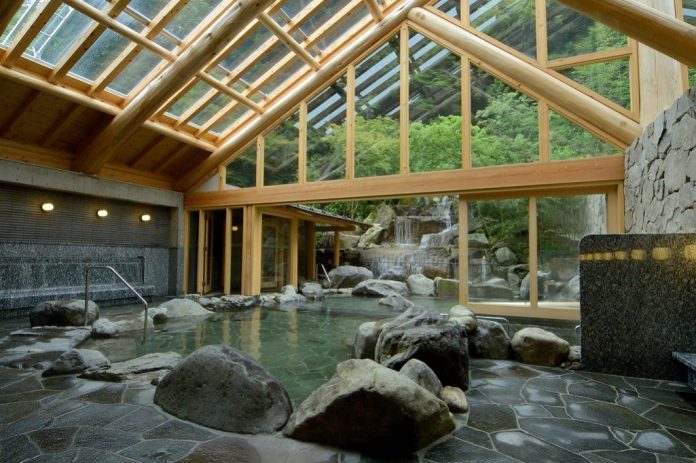Page Contents
Onsen Bath
Japan’s mountainous, volcanic terrain is home to tens of thousands of thermal hot spots, of which some 2,000 have been harnessed for tourists. Water springs, mud baths, and hot sand baths are all fueled by thermal activity. Various minerals are present and temperatures differ. They are often located in picturesque spots.
More than a quarter-million liters of water are emitted every minute from Japan’s hot springs, making it the world’s “onsen superpower.” Moreover, hot water over 42°C accounts for 47% of that output. Since most homes now have their own bath, there are now fewer traditional public baths, but there have been an increasing number of hot spring towns (known as onsens). Onsens utilize naturally heated water extracted from geothermal springs.
As at a sentō, all guests enter the hot spring after washing and rinsing themselves thoroughly first. A toilet is equipped with toiletries such as soap and shampoo as well as stools, faucets, and wooden buckets. Onsen offers removable shower heads, so nearly all of them are also convenient for bathing. Unless you have traces of soap on your body, you shouldn’t enter an onsen while still dirty.
Why Bathing?
Bathing is an essential part of Japanese culture, rooted in the tradition of cleanliness that emerged from the Buddhist faith’s emphasis on purity. Taking a bath also helps relieve stress and worry.
What is Onsen
“Onsen” means water, mineral water, water vapor, and other gases (except natural gas, which is composed of mostly hydrocarbons) that flow from the ground and have certain temperatures.
In other words, when its temperature reaches 25 degrees Celsius or more, it is considered to be an Onsen; however, if it contains more than one of these 19 substances, even when its temperature is lower, it is still considered an Onsen bath. A gas or vapor of water can also be an Onsen as long as such conditions are met.
Onsen Bath in Ancient Times
In ancient times, the onsen bath (hot spring) was probably popular as a means of healing injuries caused by wild animals, or by warriors healing battle wounds in remote and secluded mountain fastnesses. It is still regarded as a healing property of hot springs today.
Some Favorite Onsen in Japan’s
There is an immense number of onsens bathing located throughout Japan’s different islands due to its volcanic nature. Hot springs attract many travelers who wish to be cured or relax, as well as inns that serve local dishes.
-
Rotenburo – a Japanese open-air bath – is often set amidst trees with a grand view, especially if a ski slope is nearby.
-
The Takara River offers several open-air baths at Takragawa Onsen in Tochigi Prefecture.
-
Among Japan’s most renowned hot springs, Kusatsu Onsen has the distinction of holding the largest volume of water. There are approximately 4,000 liters of water released each minute, and it is consistently rated as the best onsen in Japan!
-
There are many different kinds of onsen, the most popular of which are roten-buro, outdoor baths, and noten-buro, indoor baths. Jigokudani Monkey Park features open-air Roten-buro onsen performed by Japanese macaques.
-
Moreover, Noboribetsu Onsen is the largest hot springs complex in Hokkaido, having been established more than a century ago. Thermal water is produced by a variety of naturally occurring minerals. It is said to treat all types of illnesses and disorders.
-
Yonokawa Onsen is one of Hokkaido’s oldest hot springs. The fishing boats across the Tsugaru Strait can be seen at night. As you bathe in an outdoor onsen under the lights from the boats, you have a breathtaking view.
-
Nyuto Onsen is actually composed of a number of hot springs located in an unspoiled beech forest at Mount Nyuto’s foot. A total of five onsens can be found in the village, namely: Tsurunoyu, Ganiba, Taenoyu, Ogama, Magoroku, Kuronoyu, and Kyukamura onsens.
-
Arima is home to three types of hot springs, whose beneficial effects include improving circulation, easing joint pain, lowering blood pressure, and relieving menopause and asthma symptoms. You can also gaze at traditional geishas in this area.
-
Onsen Misasa abounds with radioactive energy and is the most powerful natural healing spring in the world. When you stay three times in the morning, it is believed to have a high level of radon. Therefore the radon enhances the body’s immune system and natural healing abilities when it is inhaled by breathing.
Side Effects
There are a few noticeable risks associated with the Onsen bath among the millions of Japanese who bathe in them every year. Onsen usage can still have potentially harmful side effects, including increasing high blood pressure or aggravating heart disease.
Some onsens with poor sanitation have been found to have a strain of Legionella bacteria. Onsen communities have improved their regulation after revealing poor sanitary practices at some onsens in order to maintain their reputations.
Hot bodies of water around the world have been reported to harbor infections, such as Naegleria species. Naegleria fowleri, associated with amoebic meningoencephalitis and many fatal cases around the world, is not known to be present in hot spring waters.
Although few instances have been observed historically in Japan, onsen exposure has not been conclusively found to cause the condition.
Open cuts, sores, or lesions are often put on notices in onsens so that bathers are reminded not to bathe.
Furthermore, onsens have been adding chlorine to their water in recent years to keep them from infecting visitors, although many purists prefer natural, unchlorinated onsens that do not reuse water but instead clean them every day.
Take frequent breaks, drink lots of water, and refrain from consuming alcohol before taking a bath. Hot temperatures can affect blood pressure, and if you don’t take precautions, you may feel dizzy, nauseated, or fainting.
The precautions discussed here, as well as proper onsen usage (such as avoiding submerging the head in the water, and thoroughly washing before entering the bath), have greatly reduced any overall risk to bathers.
Benefits of Onsen Bath
Using hot spring therapy can offer many benefits. A therapeutic bath in a hot spring is often used to treat medical conditions and promote health under the term isshūkan hitomeguri (one-week visit).
Bathing in hot springs stimulates the absorption of minerals and other substances into the body and promotes hormone production. Blood pressure goes up, heart rate increases and blood sugar level also increases as a result of the dominant sympathetic nerve.
This condition is treated through the parasympathetic nervous system, which lowers blood pressure, heart rate, and blood sugar. This hot spring bathing method alternately stimulates the sympathetic and parasympathetic nervous systems.
This eventually leads to a state of equilibrium, allowing the body to repair itself. Free radicals are believed to be responsible for 90 percent of diseases and aging. Radiation, food additives, cigarettes, pharmaceuticals, pesticides, and radiation are all sources of free radicals. Oxidation is the process by which free radicals corrode a substance.
If a person immerses themselves in healing waters for one week, they will often experience this effect. It was not a scientific study, but personal experience or word of mouth that brought this to light in the past. Atami Onsen bath is in Shizuoka Prefecture in Shizuoka Prefecture.
It was where the shogun Tokugawa Ieyasu stayed for a week of hot spring therapy just after the establishment of the Edo Shogunate. It was nothing out of the ordinary. Hot springs contain constituents that are taken in by drinking directly from the eardrum (mucosa) of the digestive tract and produce pharmacological effects.












